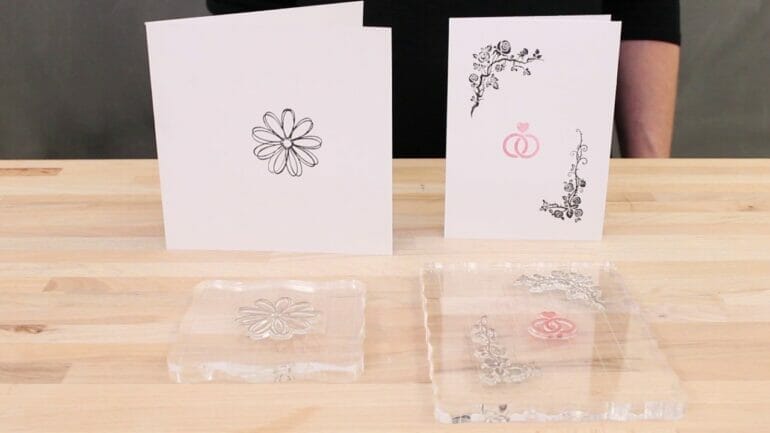Are you curious about how to use acrylic stamps? Look no further, as we have all the answers for you. Acrylic stamps are a versatile and popular tool for all your crafting needs. With a clear design and easy handling, they allow for precise and consistent stamping on various surfaces. Whether you are a beginner or an experienced crafter, acrylic stamps offer endless creativity and possibilities. In this guide, we will walk you through the step-by-step process of using acrylic stamps and share some expert tips to help you get the best results.

Choosing the Right Acrylic Stamps for Your Project
When it comes to adding decorative elements and designs to your crafting projects, acrylic stamps are a versatile and popular choice. These transparent stamps are easy to use and provide crisp and clear impressions on various surfaces. However, with so many options available in the market, choosing the right acrylic stamps for your project can be a bit overwhelming. In this section, we will guide you through the factors to consider when selecting acrylic stamps to ensure that you make the best choice for your crafting needs.
1. Design
The first and foremost factor to consider when choosing acrylic stamps is the design. Think about the theme or style of your project and select stamps that complement it. Acrylic stamps come in a wide range of designs, including flowers, animals, alphabets, sentiments, and more. Some stamps even come in sets, allowing you to create more elaborate designs.
2. Size
The size of the stamp is another crucial factor to consider. Depending on the size of your project and the area you want to stamp, you may need different sizes of acrylic stamps. Larger stamps are ideal for covering larger surfaces, while smaller stamps work well for adding intricate details or embellishments. Consider the dimensions of your project and choose the stamp size accordingly.
3. Quality
The quality of the acrylic stamps is essential for achieving clean and precise impressions. Look for stamps made from high-quality clear acrylic material that allows you to see through and ensure accurate placement. The stamps should also be deeply etched to ensure that the ink adheres evenly and produces sharp images every time.
4. Compatibility
Before purchasing acrylic stamps, it’s crucial to check their compatibility with the stamping platform you intend to use. Most acrylic stamps work well with acrylic blocks, but some may require specific platforms or tools. Ensure that the stamps you choose are compatible with your preferred stamping method to avoid any inconvenience or compatibility issues.
5. Versatility
Consider the versatility of the acrylic stamps you are considering. Some stamps are designed for specific techniques or surfaces, while others are more versatile and can be used on multiple mediums like paper, fabric, wood, and more. If you enjoy experimenting with different crafting projects, choosing versatile acrylic stamps will give you more creative options.
6. Storage and Organization
As your stamp collection grows, it’s important to consider how you will store and organize your acrylic stamps. Look for stamps that come with a storage system or consider investing in a separate storage solution. Having a well-organized stamp collection will make it easier to find the stamps you need for each project and ensure their longevity.
7. Reviews and Recommendations
Lastly, take the time to read reviews and seek recommendations from fellow crafters or online communities. Hearing about the experiences of others who have used the acrylic stamps you are considering can provide valuable insights and help you make an informed decision. Look for stamps with positive reviews regarding their durability, ease of use, and overall performance.
In summary, choosing the right acrylic stamps for your crafting project requires careful consideration of factors such as design, size, quality, compatibility, versatility, storage, and reviews. By taking these factors into account, you can ensure that your acrylic stamps enhance your creative endeavors and help you achieve beautiful and professional-looking results.

Step-by-Step Guide to Using Acrylic Stamps
Acrylic stamps are a popular tool among crafters and scrapbookers, as they provide a convenient and affordable way to add beautiful designs to various projects. Whether you are a beginner or an experienced crafter, learning how to use acrylic stamps can open up a world of creativity. In this section, we will provide you with a step-by-step guide to using acrylic stamps effectively.
Step 1: Gather Your Supplies
Before you begin stamping, make sure you have all the necessary supplies. Here’s what you’ll need:
- Acrylic stamps of your choice
- Acrylic stamping block
- Water-based ink pad
- Paper or cardstock
- Stamp cleaner or mild soap and water
- Optional: Stamp positioning tool
Step 2: Prepare Your Stamps
Start by peeling the acrylic stamps from their backing sheet. Carefully place them on the acrylic stamping block, ensuring they adhere securely. If your stamps are brand new, you may need to prime them by stamping them on scrap paper a few times to remove any residue.
Step 3: Ink Your Stamp
Press your ink pad onto the stamp, making sure the entire design is covered with ink. Avoid applying too much ink, as it can result in smudged or blurry images. If you’re using multiple colors, clean the stamp between each use to prevent color contamination.
Step 4: Position and Stamp
If you’re using a stamp positioning tool, follow the manufacturer’s instructions to position your stamp accurately. Otherwise, carefully align the stamp on your paper or cardstock. Apply even pressure to the stamp, pressing it down firmly. Hold for a few seconds to allow the ink to transfer onto the surface.
Step 5: Clean and Care for Your Stamps
After each use, it’s essential to clean your acrylic stamps to maintain their quality and prolong their lifespan. If you have a stamp cleaner, follow the instructions provided. Alternatively, you can use mild soap and water. Gently scrub the stamps with a soft-bristled brush, then pat them dry with a clean cloth or paper towel.
Step 6: Practice and Experiment
Like any craft skill, using acrylic stamps takes practice. Experiment with different ink colors, papers, and stamping techniques to discover what works best for you. Don’t be afraid to make mistakes; they can lead to unexpected and unique designs.
Step 7: Store Your Stamps Properly
To keep your acrylic stamps organized and in good condition, store them in a cool, dry place away from direct sunlight. You can use a storage container or binder with plastic sleeves to protect them from dust and damage. Additionally, consider labeling your stamps for easy identification.
In summary, using acrylic stamps is a simple and enjoyable way to enhance your crafting projects. By following these step-by-step instructions, you’ll be able to create beautiful designs and add a personal touch to cards, scrapbooks, and other creative endeavors.

Tips and Tricks for Getting Perfect Stamped Images
When it comes to creating beautiful stamped images, there are a few tips and tricks that can help you achieve perfect results every time. Whether you are a beginner or an experienced stamper, these techniques will take your cardmaking and paper crafting to the next level.
1. Use Quality Stamps
The first step to getting perfect stamped images is to invest in high-quality stamps. Look for stamps made from clear or photopolymer material, as these allow for precise placement and easy alignment. Cheaper, low-quality stamps may not give you the crisp and clean images you desire.
2. Prepare Your Stamping Surface
Before stamping, make sure your stamping surface is clean and free from any debris or residue. Use a stamp cleaner or mild soap and water to remove any ink or dirt that may affect the image transfer. A clean surface ensures a clear and even impression.
3. Use the Right Ink
Choosing the right ink is crucial for achieving perfect stamped images. Different inks work better with certain types of stamps and surfaces. If you are using clear stamps, dye-based inks are a great option as they dry quickly and provide vibrant colors. For more detailed or intricate designs, pigment inks or archival inks are recommended as they provide better coverage and crisp lines.
4. Practice Proper Stamping Technique
Proper stamping technique is essential for getting perfect results. Start by applying even pressure to the stamp, making sure to cover the entire surface with ink. When stamping, avoid rocking the stamp as this can smudge the image. Instead, press the stamp straight down onto the paper or cardstock and hold it in place for a few seconds to allow the ink to transfer.
5. Use a Stamping Tool
If you struggle with getting consistent results, using a stamping tool can be a game-changer. Stamping tools, such as a stamp positioner or stamp platform, allow for precise alignment and multiple stamping attempts. These tools ensure that your image is perfectly positioned and can be restamped if needed.
6. Experiment with Different Papers
The type of paper you use can greatly affect the quality of your stamped images. Experiment with different types of paper, such as smooth cardstock, watercolor paper, or vellum, to see which works best with your stamps and inks. Some papers may absorb more ink, while others may provide better blending or embossing results.
7. Practice, Practice, Practice
Like any skill, stamping requires practice. Take the time to experiment with different techniques, inks, and stamps. Practice stamping on scrap paper or create a stamping journal to document your progress. The more you practice, the more confident you will become in achieving perfect stamped images.
8. Clean Your Stamps After Each Use
To ensure the longevity of your stamps and maintain their quality, it is important to clean them after each use. Use a stamp cleaner or mild soap and water to remove any ink residue. Dry the stamps thoroughly before storing them to prevent any damage or warping.
9. Store Your Stamps Properly
Proper storage of your stamps is essential to keep them in excellent condition. Store your stamps in a cool and dry place away from direct sunlight. Use storage folders or clear envelopes to keep your stamps organized and easily accessible.
10. Have Fun and Get Creative
Stamping is a fun and creative hobby, so don’t be afraid to experiment and let your imagination run wild. Mix and match different stamps, colors, and techniques to create unique and personalized projects. Enjoy the process and embrace any imperfections, as they often add character and charm to your stamped images.
Summary
Creating perfect stamped images is all about using high-quality stamps, preparing your stamping surface, using the right ink, practicing proper stamping technique, and experimenting with different papers. Take the time to practice and refine your skills, clean and store your stamps properly, and most importantly, have fun and let your creativity shine.
Exploring Creative Techniques with Acrylic Stamps
Acrylic stamps have become a popular choice among crafters and artists due to their versatility and ease of use. These clear stamps are made from transparent acrylic material and are mounted on clear blocks for easy positioning and stamping. They can be used with various inks and mediums, allowing artists to create unique and stunning designs. In this section, we will explore some creative techniques that can be used with acrylic stamps to take your crafting to the next level.
1. Layering Stamps
One of the most exciting techniques with acrylic stamps is layering. Layering stamps involves stamping multiple images on top of each other to create depth and dimension. With clear acrylic stamps, it is easy to see through the stamp and align it perfectly with previously stamped images. By using different colors or shades of ink, you can achieve beautiful and intricate designs.
2. Masking
Masking is a technique that allows you to create the illusion of depth and overlapping images. To mask using acrylic stamps, you will need to stamp an image on a piece of masking paper and cut it out. Place the mask over the stamped image, and then stamp another image on top. When you remove the mask, it will appear as if the second image is behind the first, giving a realistic and layered effect.
3. Embossing
Embossing adds texture and dimension to stamped images. To emboss using acrylic stamps, you will need heat embossing powder, a heat gun, and an embossing ink pad. Stamp your image using the embossing ink, sprinkle the embossing powder over the wet ink, and then heat the powder with the heat gun until it melts and becomes raised. The result is a beautiful raised design that adds a touch of elegance to your stamped creations.
4. Watercolor Stamping
Acrylic stamps work wonderfully with watercolors, allowing you to create beautiful hand-painted effects. To achieve the watercolor stamping technique, ink your acrylic stamp with watercolors instead of traditional ink pads. Mist the stamp lightly with water before stamping it onto your paper. The water will reactivate the watercolors, creating a soft and blended look. Experiment with different colors and techniques to create stunning watercolor stamped designs.
5. Resist Stamping
Resist stamping is a technique that involves creating a resist barrier on your paper to prevent ink or paint from adhering to certain areas. To achieve this effect, stamp your acrylic image onto your paper using a clear embossing ink or a VersaMark ink pad. Then, cover the stamped image with clear embossing powder and heat set it with a heat gun. Once the embossed image cools, apply your ink or paint over the entire surface. The embossed image will resist the ink, creating an eye-catching and unique design.
6. Faux Letterpress
Faux letterpress is a technique that mimics the look of letterpress printing using acrylic stamps. To achieve this effect, ink your acrylic stamp with a pigment ink pad and firmly press it onto your paper. Use a brayer or a bone folder to apply even pressure, ensuring the ink transfers smoothly. The result is a crisp and debossed image that resembles the elegant style of letterpress printing.
In summary, acrylic stamps offer a world of creative possibilities in the crafting and art world. Whether you are a seasoned crafter or just starting out, these stamps can elevate your designs to a whole new level. Experiment with different techniques and mediums to create unique and stunning stamped creations. Let your imagination run wild and have fun exploring the endless possibilities with acrylic stamps!
FAQs
How do I use acrylic stamps?
To use acrylic stamps, start by peeling the stamp off its backing sheet and placing it on an acrylic block. Apply ink to the stamp using an ink pad, then press the stamp firmly onto your desired surface. Lift the stamp off to reveal your stamped image. Clean the stamp with water or stamp cleaner after each use.
Conclusion
In conclusion, acrylic stamps are a versatile and easy-to-use tool for any paper crafting enthusiast. With their ability to cling to clear blocks, they offer precise and accurate stamping. Whether you are a beginner or an experienced crafter, acrylic stamps are a great addition to your collection.
By following a few simple steps, you can achieve professional-looking results with acrylic stamps. Start by preparing your stamping surface and selecting the right ink for your project. Then, simply press the stamp onto the ink pad, position it on your desired surface, and apply gentle and even pressure.
With a wide range of designs and themes available, acrylic stamps allow you to unleash your creativity and add a personal touch to your projects. So why wait? Start exploring the world of acrylic stamping and enjoy endless possibilities for your artistic endeavors!
